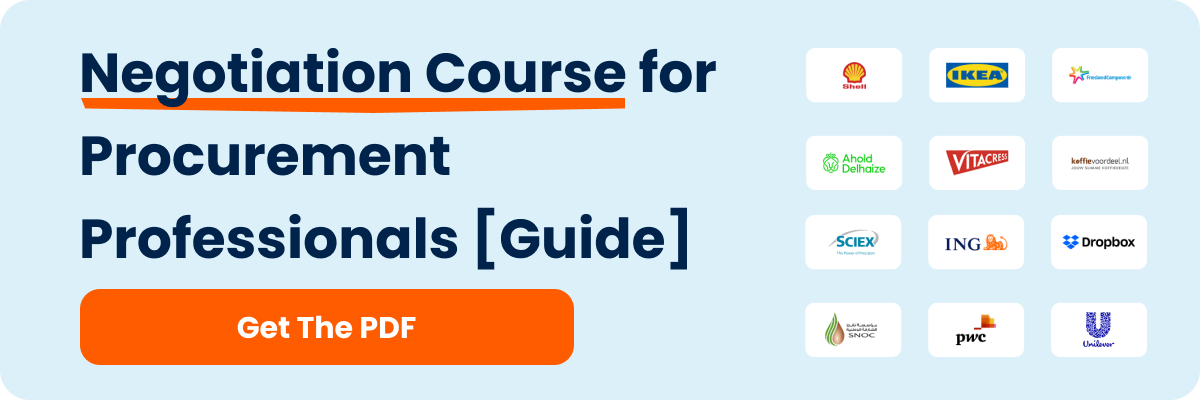Written by Marijn Overvest | Reviewed by Sjoerd Goedhart | Fact Checked by Ruud Emonds | Our editorial policy
Carrots And Sticks — The Ultimate Guide

As taught in the Negotiation Course for Procurement Professionals / ★★★★★ 4.9 rating
What are Carrots and Sticks?
- Carrots and sticks are a metaphorical strategy involving the “carrot” or “reward” and the “stick” or “punishment” for persuading someone to do something against punishment by refusing it.
- Successful negotiations require a focus on important variables, creative trade-offs, and finding win-win opportunities.
- This tactic adds value to gathering crucial information while finding the best possible outcome.
What are Carrots and Sticks?

In the world of employment and work management, the term ‘carrots and sticks’ means a motivational approach that involves offering a reward, hence the term “carrot” for those who work really well, while the opposite side gets the “stick” or a punishment for not doing their utmost performance. To make the term simpler, the carrots and sticks system is a form of feedback system set for employees.
The term is not just used in employment and work management. The term is also used in politics and negotiations. In fact, negotiators often use the carrots and sticks system as a way to get the other party to agree to their demands.
As an experienced negotiator, the more tools you can use to get your desired results during a negotiation, the better, correct? With that being the case, it’s time to examine the best carrots and sticks examples that one can use to gain an advantage during negotiations.
How to Use Carrots and Sticks in Negotiations?
This guide demonstrates how to effectively implement the “sticks and carrots” approach when engaging with suppliers in your negotiations. By using the template provided below, you can tailor specific carrots (rewards or positive incentives) and sticks (punishments or negative consequences) for each supplier.
The process involves evaluating potential trade-offs that you’re willing to make and determining concessions necessary to reach your desired outcome. By carefully outlining these trade-offs, you can gain insight into the perspective of the other party, which is crucial in developing a strategic negotiation plan.
This method not only helps you to clearly define your incentives and deterrents but also equips you with the leverage needed to propose mutually beneficial terms. The goal is to induce the supplier to agree to a win-win deal, ensuring that both parties secure outcomes that meet their respective needs and objectives.
Ultimately, the success of this strategy lies in striking the right balance between firmness and flexibility. By thoughtfully applying the right mix of incentives and deterrents, you can steer the negotiation process toward a resolution that benefits everyone involved.

The Best Carrots and Sticks Examples to Use in Negotiations
In the world of procurement, the procurement process often talks about how to source and negotiate with suppliers regarding the best amount and quality of materials versus the price the organization is willing to pay for those materials. We’ve talked about that in our procurement process article.
For the negotiator, agreeing to pay for the high-quality material comes as the “carrot,” while trying to come off cheap but getting inferior quality materials in the process becomes the “stick”. This example is aimed towards procurement teams that are looking to procure high-quality materials, but at the cost of pricing.
The incentives and penalties system is a way of rewarding and punishing companies that choose to either follow the right path in acquiring materials or want to go through the shortcuts through dubious means.
1. Real-Life Example: Supplier Contract Negotiation
Carrot: Offer your supplier incentives such as a volume discount or a commitment to a long-term contract if they can meet specific performance criteria (e.g., on-time delivery, consistent quality). You might also propose a prompt payment discount, rewarding them for faster invoice processing.
Stick: At the same time, include contractual penalties such as financial deductions for each day of delay or a reduction in future orders if quality standards are not met. This creates a clear consequence for underperformance, encouraging the supplier to maintain high standards.
2. Real-Life Example: Employee Performance Negotiation
Carrot: In negotiations with an employee about performance targets, offer rewards like performance bonuses, extra vacation days, or professional development opportunities if they exceed set goals. This not only motivates the employee but also creates a clear benefit for outstanding performance.
Stick: Conversely, establish clear performance expectations by outlining that failing to meet these targets may lead to performance improvement plans, reduced responsibilities, or even reconsideration of their position. This ensures that the employee is aware of the negative implications of not meeting expectations.
My Experience With Carrots and Sticks
As an experienced negotiator, the more tools you can use to get your desired results during a negotiation, the better. Right? It’s time to examine the best carrots and sticks examples that you can use to gain an advantage during negotiations.
The rewards that come from using the carrot and the stick method are a successful win-win situation. I will share some ideas and best practices to use when implementing this strategy.
We don’t hear the phrase “carrot and the stick” as much as I used to. Gives and takes are two words for the same concept. Thinking of the important variables for you and your negotiation opponent communicates that we recognize the perspective of our opponent. Think about needs, aspirations, concerns, and pressure points: often the key to a win-win result.
Setting aside our self-interest priorities for a moment, just to consider how our counterpart might feel, is a game-changer. When it comes to employing the power of rewards, creativity and ‘out-of-the-box thinking are typically required. Looking at a negotiation from your opponent’s perspective can spawn proposals that might induce them to agree to a win-win deal.
When conducting a supplier negotiation strategy myself in my time as Procurement Manager, I focused more on carrots than on sticks. As a person, I truly believe that better negotiation results come from a positive approach instead of a negative one. I spent hours calling, researching, and asking questions to make sure I understood all possible wants and needs that my suppliers could have before entering the negotiation. When determined, think of value in dollars to ask back when presenting the ‘carrot’ to the supplier. In cases where no agreement was reached because of any discussion about the value of the ‘carrot’, I turned the carrot into a stick by not giving the supplier what they wanted.
I only used sticks when negotiations didn’t go my way at all: examples of this were moving business to other suppliers, delisting of assortment, shorter contract periods, and so on, and so on.
Tips on Using Carrots and Sticks
The team of Procurement Tactics helps you out with some concrete tips on how to use the Carrot and Stick principle towards suppliers yourself:
- I’ll consider buying a larger quantity if you can give me a 10% discount. ‘Here, the reward is a higher volume. ’
- If you can do it for that price, I’ll recommend you to my friends and even write a testimonial letter for your promotional use. ‘Here, the reward is more future business.’
- I’d consider purchasing some of your other products if you can help me with this order. ‘Here, the reward is a bigger deal. ’
- I can reduce my price on this order if you pick this up at our warehouse by Friday. ‘Here, the reward is a price discount. ’
You are likely more creative than I when it comes to identifying rewards in your own situation. Coming up with incentives becomes easier when you concentrate your efforts and thoughts in that direction. What are the possibilities in your negotiations? What inexpensive thing could you give up as a reward that would convert your opponent’s hesitancy into action? Good negotiators recognize trade-off possibilities when offering incentives or rewards.
You can use this template to help you with your trade-offs:

Conclusion
Carrots and sticks are not usually heard as it is the same as give and take. Carrot equates to give and stick with take. Additionally, you have to ensure that you have an endless list of gives and takes. Not doing so will not give you the best result in a negotiation.
Thus, you should focus more on what is the most important variable with the negotiating party before you go to war.
Also, make a long list of the important variables for both you and the negotiating party. The more variables on your list, the better. Try ranking them before you start the negotiation. You must take note that the best deals are created when you exchange the variables with a low value to you and a high for the other party instead of the ones with a high value to you and a low for your counterpart.
I have created a free-to-download editable in-negotiation toolkit template. It’s a PowerPoint file that can help you create the best approach when negotiating with other parties. I even created a video where I’ll explain how you can use this template.
Frequentlyasked questions
What is the definition of carrots and sticks?
Carrots and sticks are characterized by the use of both reward and punishment to induce cooperation in an organization.
What is another term for carrots and sticks?
Carrots and sticks approach is also often called give and take.
What is the incentives and penalties system?
Penalties system is a way of rewarding and punishing someone that chooses to either follow the right path in acquiring materials or they want to go through the shortcut through dubious means.
About the author
My name is Marijn Overvest, I’m the founder of Procurement Tactics. I have a deep passion for procurement, and I’ve upskilled over 200 procurement teams from all over the world. When I’m not working, I love running and cycling.







